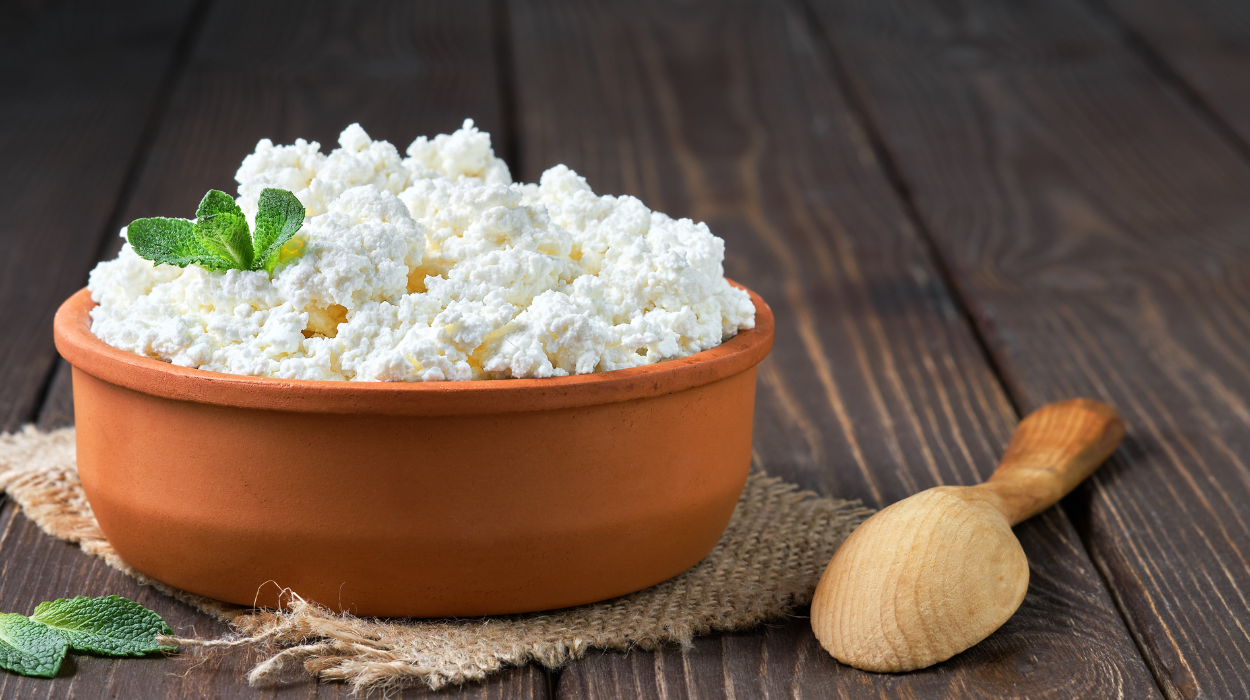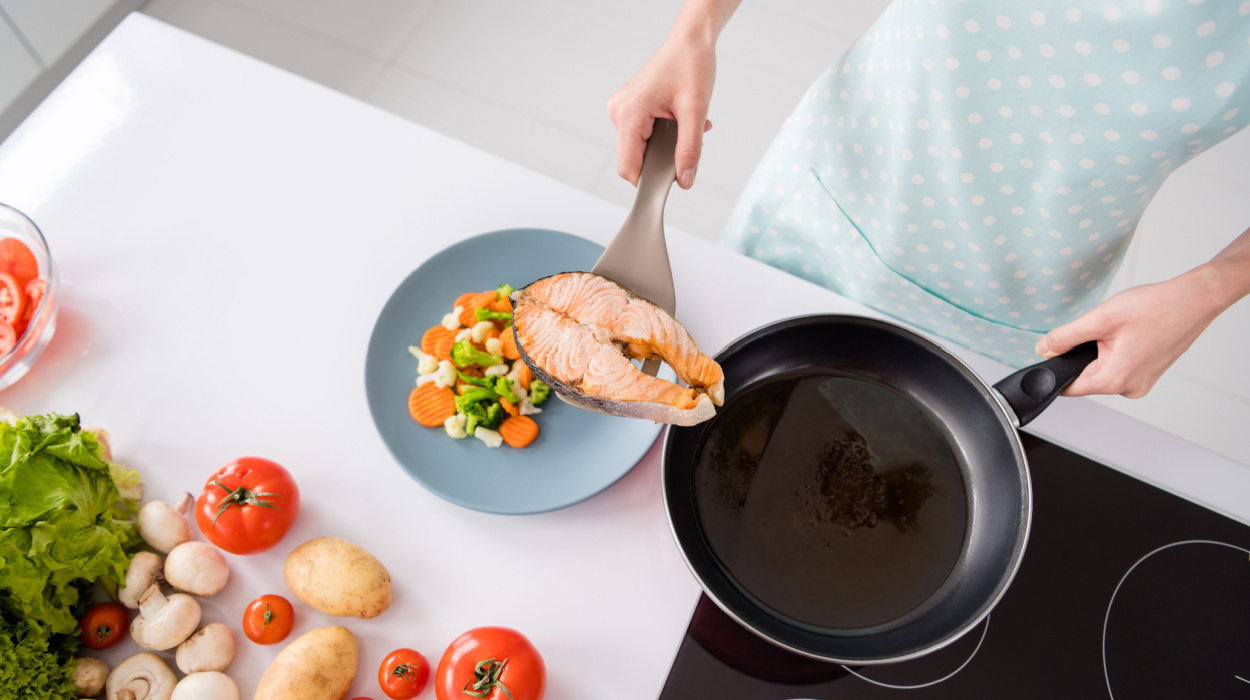Figuring out what to eat when trying to lose weight isn’t always easy. Different diet plans give conflicting recommendations, often leaving you confused. The best thing you can do is turn to scientific evidence, which will tell you what really works.
When looking at the research, one thing becomes clear: high protein foods for weight loss are actually effective. Clinical studies[1] consistently find that protein supports weight loss efforts.
A protein-rich diet can help people lose weight because it is more filling. There are additional reasons that protein with all nine essential amino acids helps with weight loss. But first, let’s learn about foods that will add more high-quality protein to your diet.
High-Protein Foods List For Weight Loss
High protein food is one of the top choices for weight loss. If you’re trying to lose weight, consider the options below:
- Fish.
- Chicken breast.
- Cottage cheese.
- Lean beef.
- Eggs.
- Quinoa.
- Almonds.
- Protein bars.
- Greek yogurt.
- Black beans.
- Peas.
- Pumpkin seeds.
Best High-Protein Foods For Weight Loss
Eating more protein rich in essential amino acids can aid weight loss, so eating complete protein is important if you want to lose weight. If you’re looking for specific examples for your own diet, the following food list for weight loss is helpful.
Fish
There are numerous fish varieties, many of which will add a protein boost to your diet. For example, an 87-gram tilapia filet[2] contains nearly 23 grams of protein. It’s also a lean protein source, adding just 2 grams of fat and 111 calories to your diet.
If you’re also prioritizing healthy fats,[3] you might prefer salmon. A single filet[4] packs 17 grams of protein, as well as about 11 grams of healthy fat.
Salmon has a slightly higher calorie content than tilapia, at about 180 calories per filet. This is because it’s a fatty fish.
Mahi Mahi is another high-protein option that will keep your calorie intake within a reasonable limit. One filet[5] comes in at about 93 calories and 20 grams of protein. This is a lower-fat option than salmon but also packed with protein.
Chicken Breast
If you’ve ever done any research into healthy weight loss, you’ve probably heard that chicken breast is a fan favorite. A 4-ounce breast[6] contains 26 grams of protein for only 120 calories, so it’s understandable why it’s so popular.
Chicken breast is a great choice When trying to eat fewer calories. In fact, chicken is often regarded as one of the best high-protein foods for weight loss and muscle gain.
You might be thinking that chicken breast seems boring. Fortunately, plenty of zero-calorie seasonings can add a flavor boost. You could also pair chicken breast with side dishes or use it to make a favorite, like chicken tacos.
Cottage Cheese

If you enjoy the taste, low-fat cottage cheese can be a great addition to a high-protein diet. One cup[7] packs about 24 grams of protein and 180 calories.
The nice thing about cottage cheese is that it’s also a versatile food. So, you can include it in various different snacks and meals during your weight loss journey. Interestingly, eating eggs and cottage cheese during meals led to comparable levels of satiety.[8] This is an important scientific result for those who want to lose weight.
Pair it with fresh fruit for a balanced breakfast, or use it as a side item for lunch or dinner. You can also have it as a snack between meals if you want to stay full.
Lean Beef
If you choose lean varieties, beef could help you lose weight. Be sure to choose the 93% lean version to avoid going too high on calories. Consuming about 100 grams of lean beef[9] will provide almost 24 grams of protein for around 170 calories.
For a meal, pair one serving of lean beef with veggies. This will provide other nutrients from veggies. For instance, half a cup[10] of chopped broccoli provides a high dose of vitamin C and only 15 calories.
You might think that you can’t enjoy a burger when trying to lose weight. A burger might not be so bad if you choose a lean beef patty and ditch the bun. Also, you must watch out for your calorie intake with burger sauces, which can be a calorie bomb.
Eggs
Sometimes people think eggs are on the list of foods to avoid for weight loss because of their cholesterol content. However, eggs are actually quite healthy, and they can support weight loss.
Experts have concluded[11] that research demonstrates egg consumption is safe. They’ve also stated that eggs promote weight loss because they’re a cheap, nutritious protein source.
Go ahead and add an egg or two a day to your diet for some high-quality protein. One medium[12] egg has about 5.5 grams of protein and 60 calories.
You can top a salad with a hard-boiled egg for a low-calorie, protein-rich meal. Or scramble some eggs for breakfast. Some people even enjoy a hard-boiled egg as a snack to hold them off until dinner.
Quinoa
If you’re looking for plant protein sources, quinoa is a good choice. A one-cup serving[13] has about 220 calories and 8 grams of protein.
Like cottage cheese, quinoa is pretty versatile. Use it as a side dish for extra protein, or make a meal out of it. Top it with veggies, and you have a simple, healthy dinner.
Another benefit of plant-based protein sources like quinoa is that they are rich in nutrients. Quinoa is packed[14] with fiber, vitamins, minerals, and essential amino acids. Foods like this aid weight loss and give you the nutrients you need to feel your best.
Almonds
Almonds are another plant-based protein source that could help with weight loss. One serving,[15] about 30 grams, contains 6 grams of protein, making this a good choice for a protein boost.
You can enjoy almonds as a crunchy snack or use them to top salads for some extra protein. Just be sure to measure your portions because one serving contains about 160 calories. If you overeat almonds, you could experience weight gain.
Almonds can help you meet your weight loss goals as long as you manage your portion sizes. They also come with significant health benefits. For example, they have been shown[16] to reduce heart disease risk factors, such as high LDL-cholesterol levels.
Protein Bars
While sticking to whole-food protein sources is often preferred, sometimes you need a little help. In that case, a protein supplement can be beneficial. A protein bar or adding protein powder to smoothies or other recipes can help you meet your daily protein intake if you’re a little short on complete protein and don’t want to add saturated fat to your diet.
Whey protein is one of the highest-quality protein powder sources for getting all nine essential amino acids. Whey protein powder is a good choice because research has shown[17] it is effective for weight loss.
Keep in mind that this should just be for a protein boost. Consuming a balanced diet is important to get plenty of essential nutrients. So, protein bars are okay here and there, but your entire diet shouldn’t consist of them.
Greek Yogurt
High-protein diets are likely to contain Greek yogurt because it’s such an excellent source of protein. A 200-gram[18] serving of plain, low-fat Greek yogurt contains nearly 20 grams of protein. This portion contains just under 150 calories, which is reasonable if you’re trying to lose weight.
Greek yogurt makes a great snack between meals. You can also top it with fruit for a balanced breakfast. If you’d like to get creative, use Greek yogurt instead of sour cream.
Use Greek yogurt to add some protein to a baked potato or a taco salad. A half-cup serving, which is pretty large, will give you 10 grams of protein. It will also contain fewer calories than an equal amount of sour cream.
Black Beans
If you’re trying to limit animal foods, try black beans for plant-based protein. A half-cup serving[19] provides about 7.5 grams of protein and 115 calories.
Black beans are great as a side dish for dinner. You can also use them in recipes to increase the protein content. For example, they make a great addition to salads, soups, tacos, or salsas.
Beyond being a good protein source, black beans benefit overall health. Research shows[20] that they contain high amounts of antioxidants, which are good for heart health and reduce diabetes risk.
Peas

For those who want to add more veggies to their diet, peas can provide a good source of protein. A one-cup serving[21] offers 8 grams of protein and about 120 calories, making peas one of the top high-protein veggies.
You might be surprised to learn this because we don’t often think of veggies being rich protein sources. It turns out that pea protein is actually legitimate!
Use peas as a side dish with a piece of lean meat or fish, and you’ll have a protein-rich meal. You can also add them to rice or other side dishes for extra protein.
Pumpkin Seeds
Rounding out the best high-protein foods for weight loss are pumpkin seeds. A one-cup serving[22] provides nearly 14 grams of protein!
You may want to limit yourself to a half-cup of these high-protein seeds. They are rich in protein, but a cup has 264 calories. Sticking to half a serving will still provide 7 grams of protein and a satisfying flavor for fewer calories.
You can often find pumpkin seeds at natural foods stores or online retailers if you aren’t sure where to start.
Why Is Protein Intake Important for Weight Loss?
There are several reasons that protein contributes to weight loss. These are described in more detail below.
The Thermogenic Effect Of Protein
First, protein is thermogenic,[1] meaning it increases your calorie burn. It does this in two ways: by burning more calories when you eat and by increasing resting metabolism.
Protein specifically increases diet-induced thermogenesis,[1] which is the number of calories the body burns absorbing and storing nutrients. When you consume high-protein foods, your body burns 20-30% of the total calories consumed through diet-induced thermogenesis. This is compared to 5-10% for carbohydrates and 0-3% for fats.
In addition, protein raises your resting metabolism, so you burn more calories total per day. Protein produces a higher metabolic rate, particularly during sleep.[1] This is achieved through increasing muscle mass[23] to increase metabolism.
Preserved Muscle Mass
Another reason protein is beneficial for weight loss is that it helps you maintain muscle mass. When people lose weight, their metabolic rate decreases because of a loss of muscle mass.
Fortunately, research shows[1] that high protein consumption helps to preserve muscle mass with weight loss. This, in turn, keeps the metabolic rate higher, making continued weight loss easier.
Furthermore, a higher protein diet can increase muscle mass when combined with strength training. This is important because muscle growth can increase resting metabolism.[23]
Increased Satiety
Finally, protein helps with weight loss by increasing feelings of satiety.[1] This means you’ll be full and satisfied with a higher-protein diet.
If you feel full after eating, you’ll consume fewer calories. In this way, high protein intake can make it easier to stick to a calorie deficit for weight loss.
You might think this sounds similar to drinking water to lose weight, but it’s a little different. Water and protein can both make you feel full, but protein’s effects are unique.
Protein increases hunger-reducing hormones[1] and levels of blood aminos acids. Both of these processes lead to increased satiety.
Conclusion
Losing weight is likely to be easier with a diet high in quality protein. Healthful foods that provide a good source of protein will keep you full. They also have a thermogenic effect, meaning you’ll burn more calories when you consume them.
While a high-protein diet is beneficial for weight loss, be sure to include a variety of foods. This allows you to get other nutrients, such as vitamins and minerals.
It can be easy to get stuck eating only meats and dairy products when you’re following a high-protein diet. Remember, these are not the only options. There are plenty of plant proteins, such as almonds, quinoa, and peas, that pack a powerful protein punch.
Furthermore, it’s still important to be in a calorie deficit and get plenty of exercise on a high-protein diet. We would all love if eating more protein was a magic tool for weight loss, but it’s not. It just makes the process easier.
Frequently Asked Questions
Eating protein is beneficial for weight loss. A high-protein diet keeps you full, plus protein is thermogenic.[1] This means it increases calorie burn.
It depends on what your daily protein goals are. Two medium[12] eggs have about 12 grams of protein. This is not even one-third of your needs for the day for a typical person.
Protein needs for weight loss can vary. The general recommendation for athletes[24] is 1.6-2.4 grams of protein per kilogram of body weight each day. The general population[25] needs about 1.2-1.5 grams per kilogram of body weight daily.
Protein is thermogenic,[1] meaning it increases your calorie burn. However, you should not rely on protein intake alone. Exercise further increases your calorie burn, and it’s important for overall health.
A cup of oats[26] provides 307 calories and 10.7 grams of protein. This can add a protein boost, but be sure to be mindful of total calories. There are other food options that provide the same protein content for fewer calories.
 Evidence Based
Evidence Based
